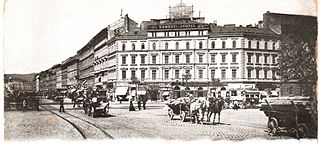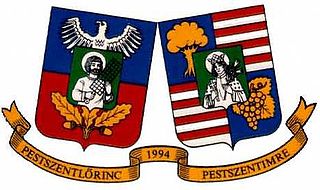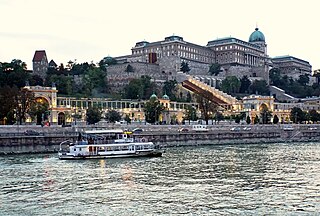 W
WAngyalföld is a neighbourhood in Budapest, Hungary. Administratively it belongs to the 13th district. The traditionally working-class neighbourhood went through a process of gentrification due to the office-building boom of the 1990s.
 W
WThe Citadella is the fortification located upon the top of Gellért Hill in Budapest, Hungary. Citadella is the Hungarian word for citadel, a kind of fortress. The word is exclusively used by other languages to refer to the Gellért Hill citadel which occupies a place which held strategic importance in Budapest's military history.
 W
WErzsébetváros is the 7th district of Budapest, situated on the Pest side of the Danube. The inner half of the district was the historic Jewish quarter of Pest. The Dohány Street Synagogue, the largest functioning synagogue in Europe, is located in this district. Currently it is the most densely populated district of Budapest with 29,681.3 person per km2. In 1910 Erzsébetváros had 152,454 inhabitants. During the socialist era Erzsébetváros's population decreased rapidly, because young people and families moved to the newer "panelized" boom districts. Gentrification and recovery started in the middle of the 2000s.
 W
WHegyvidék is the official name of the XII district of Budapest, capital of Hungary. It is a region of Buda, on the west bank of river Danube.
 W
WJános Hill is the highest point of Budapest with a height of 528 m (1,732 ft). From Elizabeth Lookout on the top of the hill one can get an impressive panoramic view of the whole region.
 W
WKelenföld is a neighborhood in Budapest, Hungary. It belongs to Újbuda, and located in the southern part of Buda. The large Kelenföld housing estate was built between 1967 and 1983 from pre-fabricated concrete blocks. The older streets around Bocskai út were mainly built in the first half of the 20th century. The Kelenföld railway station is an important transport hub of Buda, especially since 2014, when it gained convenient access to the city center thanks to the newly opened Metro Line M4. Kelenföld Power Station, the largest electrical generation plant in the world after its construction in 1912, is now a tourist attraction and has received coverage in the English-speaking world in recent years thanks in part to its Art Deco control room.
 W
WKrisztinaváros is a neighbourhood in central Budapest, situated just west of Castle Hill, north of Tabán. It is named after Archduchess Maria Christina, daughter of Maria Theresa, who interceded for buildings to be erected in this area. The history of Krisztinaváros is inseparable from that of the neighboring old Tabán, Naphegy and Gellérthegy.
 W
WLake Feneketlen is a lake in the 11th district of Budapest, Hungary.
 W
WLipótváros is a traditional neighbourhood in the city centre of Budapest, named after King Leopold II. It is one of the two neighbourhoods of District V, the other one being Inner City (Belváros), which is the old town of Pest. Lipótváros was established in the early 19th century, and became the political and financial centre of Hungary in the early 20th century when the Parliament was built on Kossuth Square. Many ministries followed in the later decades. After the 1989 change Lipótváros gradually became again the business centre of Budapest with many banks and office buildings. The neighbourhood is rich in listed historic buildings and landmarks.
 W
WMóricz Zsigmond körtér is a square in Budapest, Hungary.
 W
WOktogon is one of Pest's major intersections, located at the junction of the Grand Boulevard (Nagykörút) and Andrássy Avenue in Budapest, Hungary. This junction, one of the city's most important, is named for its octagonal shape.
 W
WPasarét is a neighbourhood on the Buda side of Budapest.
 W
WNépliget or People's Park is the biggest public park in Budapest, Hungary. It is located southeast of the city centre, and covers an area of 110 hectares. It was established to commemorate the 100th anniversary of the union of Pest, Buda and Óbuda. The park is the site of the Planetarium, which is a laser theatre, and the E-klub, the biggest night club in Budapest.
 W
WPesterzsébet is the 20th district of Budapest, Hungary. It is located in the southern part of the capital and is the 17th biggest district in the city. It is a mostly suburban area with approximately 70,000 residents.
 W
WPestszentlőrinc‑Pestszentimre is the 18th district of Budapest is situated at the south-eastern part of the city. It is made up of two earlier distinct towns: Pestszentlőrinc and Pestszentimre.
 W
WRákoscsaba is a former town in Hungary now part of District XVII of Budapest. Rákoscsaba was united with Budapest on 1 January 1950. The Hijackers Bike Park was opened in 2013 in Rákoscsaba.
 W
WRákosliget is a part of the 17th district of Budapest since January 1, 1950. It is known to locals as 'Liget'
 W
WThe area known as Rózsadomb is a wealthy area in the 2nd district of Budapest, the capital of Hungary. It is a member of the Buda Hills.
 W
WSashalom is a neighbourhood within the XVI. district of Budapest. It is mostly a green and suburban environment away from traffic and businesses.
 W
WÜllői út is a major transport artery in Budapest, Hungary. Üllői út is the longest avenue in Budapest. It is 15.6 km long and nearly perfectly straight.
 W
WVáci utca is one of the main pedestrian thoroughfares and perhaps the most famous street of central Budapest, Hungary. It features many restaurants and shops catering primarily to the tourist market. The Lonely Planet says "It's tourist central, but the line of cafés and shops are worth seeing — at least once."
 W
WCastle Hill (Hungarian:Várhegy) is a hill in Budapest's 1st district. Geographically it is connected to the Buda Hills and Rózsadomb.